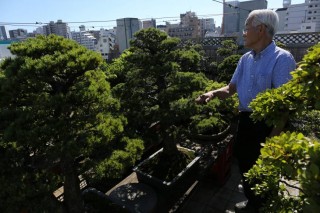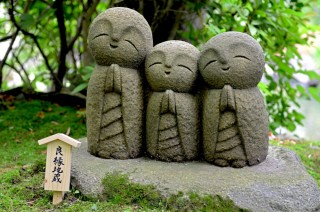Loading
Search
▼ The ‘other’ Jizo-dori: Culture Set In Stone
- Category:Spot

JAPAN TIMES
Mention Jizo-dori in Tokyo and everyone will think you mean the street in Sugamo, Toshima Ward, where the silver set combines bargain hunting with visits to the famous stone jizō (bodhisattva statue) there. Walking near Edogawabashi Station on the Yurakucho Line, I pass a less well-known Jizo-dori, in Bunkyo Ward. A sweet-faced carved stone kosodate ojizōsama (bodhisattva who protects children) housed in a shrine at street’s entrance draws me in.
“Our statue washed up here when the Kanda River overflowed,” says Keiko Uchida, an elfin 74-year-old who runs nearby sweet shop Asadaya.
A placard explains that the stone figure — almost the size of Uchida — was deemed by locals as a divine gift and has been worshipped since it was deposited here in the early Meiji Era (1867-1912).
“Ojizōsama’s face changes occasionally,” Uchida confides in me, sotto voce, “and sometimes he cries.” I raise an eyebrow. “But not everybody sees that,” she says, as she reaches for a rag and starts to rapidly beat the statue’s face with the cloth.
Keiko Uchida and her husband, Zenichi, are third-generation owners of Asadaya, which opened in 1906. “Our place burned down during World War II, along with this entire area,” she says without a yoctogram of rancor, “but we came back.”
As she sets to wrapping traditional bean cakes offered to those who bring donations to temples during O-Bon, I head out. But first, I spot something I’ve never seen before — beautiful square packets wrapped in lotus leaves.
“These are called hasu-no-ii,” she says, unfolding one to show me that this “lotus leaf well” is filled with simple white rice and black beans. “We prepare this for Buddha, who visits our home altars during O-Bon. It’s something like Buddha’s obentō (lunch box), for the return journey,” she says, laughing. “Everyone used to make them, but it’s rare to see them nowadays.”
In the hot summer air, the aroma from roasting senbei (rice crackers) from nearby shop Kisaku is too delicious to ignore. There, 65-year-old Shigeru Miyazaki braves the additional heat of a charcoal brazier — 700 to 800 degrees Celsius — to bring Kisaku’s signature crackers to what he calls a perfect “fox-color.” For the past 20 years, Miyazaki has worked eight-hour days at the job, and rarely burns a cracker.
Getting there: Jizo-dori is a five-minute walk south from Exit 2 on the Yurakucho subway line’s Edogawabashi Station.

Source : japantimes.co.jp
- August 27, 2015
- Comment (0)
- Trackback(0)

